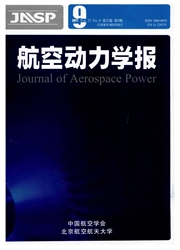

 中文摘要:
中文摘要:
在采用直接数值模拟(DNS)方法计算得到来流马赫数为4.5的带局部凸起的可压缩平板边界层基本流的基础上,基于线性稳定性理论(LST)进行稳定性分析,通过求解扰动方程研究了不同频率的扰动波与不同高度的局部凸起的相互作用,定义了穿透系数来研究局部凸起对流动稳定性的影响.研究结果表明:当局部凸起高度小于0.2个边界层厚度时局部凸起对来流的影响是局部的;局部凸起使频率小于最不稳定波频率的扰动波更不稳定,对频率大于最不稳定波频率的扰动波有稳定作用,其中最不稳定波频率是指局部凸起中心位置处平板边界层中第2模态最不稳定波的频率;穿透系数定量刻画了局部凸起对稳定性的影响,高度为0.2个边界层厚度的局部凸起引起e-N方法中N值的修正量达到0.8,接近转捩位置处N值的10%,在转捩预测中必须考虑.
 英文摘要:
英文摘要:
Direct numerical simulation(DNS)method was performed on compressible boundary layer on flat plate with a local hump,and linear stability theory(LST)was applied to conduct the stability analysis based on the mean flow with Mach number of 4.5.The interactions between the disturbances with different frequencies and the local hump with various heights were simulated by solving the perturbation equations,and the effect of local hump on the stability was characterized by a transmission coefficient.The results show that,the local hump affectes the mean flow locally when the height of the local hump is smaller than 0.2times of the boundary layer thickness.Local hump destabilizes the disturbances with frequency smaller than the most unstable disturbance frequency,and stabilizes the disturbances with frequency larger than the most unstable disturbance frequency,wherein the most unstable disturbance frequency is the frequency of the most unstable second modal disturbance of the boundary layer on flat plate at the center position of the local hump.Transmission coefficient quantitatively describes the effect of local hump on the instability.The local hump with height 0.2times of the boundary layer thickness enables the correction of the N of e-N method 0.8,about 10% of N at the transition location,which can not be neglected in the transition prediction process.
 同期刊论文项目
同期刊论文项目
 同项目期刊论文
同项目期刊论文
 期刊信息
期刊信息
